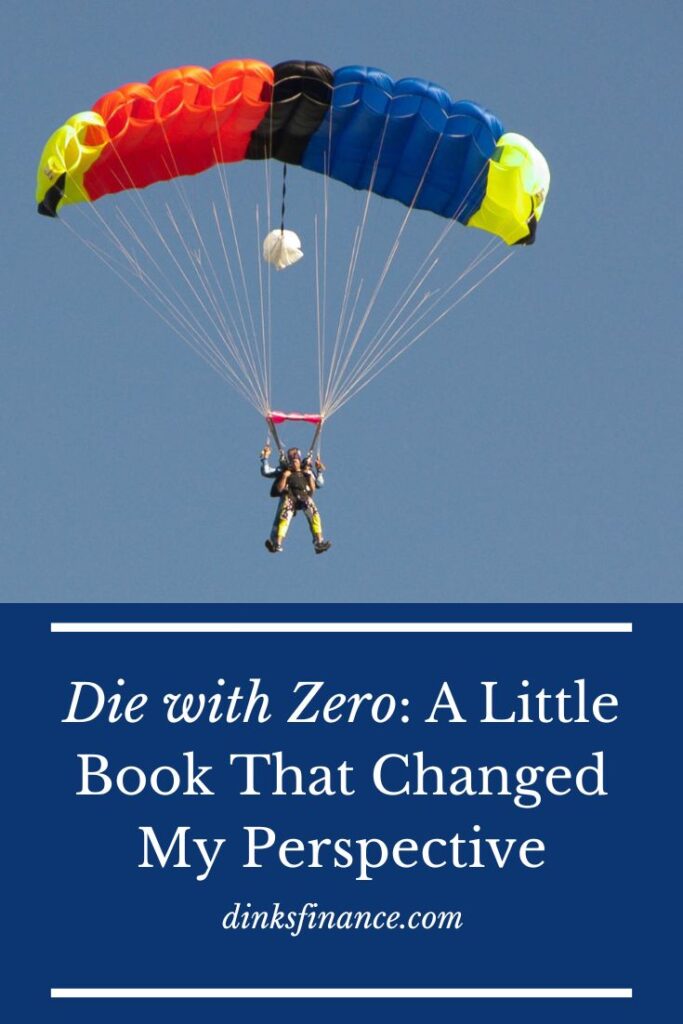
A few decades ago, I read Your Money or Your Life by Vicki Robin and Joe Dominguez. It changed the way I thought about spending money, especially the formula that looked at hours worked in relation to the price of something that you buy. For instance, if you’re going to buy a meal out, that may equate to one or two hours of work, especially if you’re young and just starting your career. After reading the book, I often asked myself whether a purchase was worth the amount of work it cost. The answer was often no, and this philosophy helped me pay off student loans and a car loan quicker than I would have without reading the book. Now, deep into midlife, I’ve read another little book, Die with Zero, that has changed my perspective on money.
Die with Zero: The Little Book That Changed My Perspective on Money
I belong to a few financial groups on Facebook, and they typically recommend different financial books. One that caught my eye was Die with Zero by Bill Perkins.
Why Die with Zero?
Why does Perkins encourage people to die with zero? Perkins sees any money you’re left with at the end of your life as unrealized potential. You didn’t get to use that money on life experiences. Instead, you spent hours, weeks, years working essentially for nothing because you didn’t use the money you earned. Perkins wants readers to use their money to experience and live life, not work to amass as much money as possible.
Carpe Diem
The biggest takeaway from this book is that it’s best to spend your money (responsibly) now because we never know how long we have.
Do you want to donate to charity? The charity needs your money now, not 40 years from now when you die. Go ahead and donate.
Do you want to leave money to your kids? Do it now. Often, parents wait to give money to their kids until they die. If parents die of old age, the kids inherit the money when they’re in their 60s or 70s. By then, they don’t need the money. The kids needed the money when they were younger to buy a house or help defray the cost of raising kids.
The Triangle of Money, Time, and Health
Perkins illustrates many of his arguments by looking at the triangle of money, time, and health.
- When you’re young, you have time and health, but not money.
- When you’re middle-aged, you may have money and health, but not time.
- And when you’re retired, you often have money and time, but not health.
Perkins argues that you should spend your money on experiences while you’re young and have your health. To Perkins, building a memory bank that you can sift through when you’re older is paramount.
How to Make Sure You Have Enough but Not Too Much
However, Perkins is not encouraging readers to be irresponsible with their money.
Rather than setting a year when readers are going to spend down their money, he encourages readers to set a dollar amount. Most people decide to start spending down their money after they retire at 65 or 67. Perkins says that’s too late. Instead, you should determine how much money you need to live in retirement.
When your net worth hits that figure, make sure you start spending down your money on experiences and giving to family and charities so that you don’t die with zero.
My Thoughts on the Book
Overall, Die with Zero has changed the way I look at money and my time. I find since reading the book, I’m a little looser with both. For instance, my husband and I always work hard, but we rarely do things because we always feel like we need to save more to secure our futures. Since reading this book, we’ve started taking more local trips to see things in our town. I’m also planning a cross-country trip that I’ve been putting off.
Likewise, I called my friend the other day and talked for 90 minutes. Before reading this book, I would have texted her because I didn’t feel like I had 90 minutes to spare. After reading this book, I recognize that time is fleeting. We never know how much time we have left, so use time wisely.
Despite the lessons I learned from this book, I have some caveats.
Risk Tolerance
Personally, I wouldn’t feel comfortable planning to die with zero. I see Perkins’ point about making sure to use the money you worked so hard for, but I don’t want to outlive my money, either. Perkins suggests that risk-averse individuals could get an annuity to make sure they don’t die with zero or could get a reverse mortgage.
Travel

Perkins strongly advocates traveling and gathering life experiences when you’re young, even if you can’t afford them. However, I worry that too many people will read this book and take his advice as permission to overspend with the assumption that they will make more in a few years to pay off that debt.
In my twenties, I went to China, Ireland, Switzerland, and Japan. Honestly, I couldn’t afford any of those trips. Some of the expenses went on my credit card. I’m glad I traveled, but I would warn younger people that even if you have plans to pay off the debt as soon as possible, sometimes life interferes. You may not make as much money in the future as you think, or you may get married. Then you will wish you didn’t have debt to pay off.
Final Thoughts
If you want to read a book that’s unlike any personal finance book you’ve read before, read Die with Zero. This little book changed my perspective on money, and it might change yours, too.
Read More
Top Personal Finance Books Worth Reading


No Comments yet!